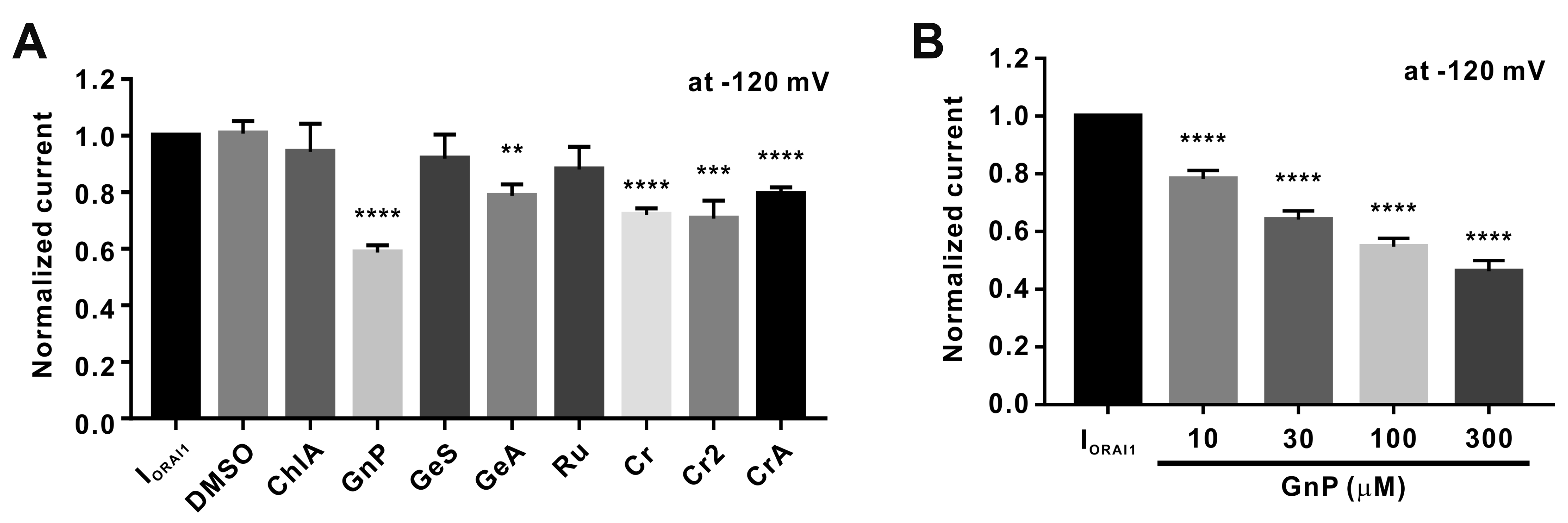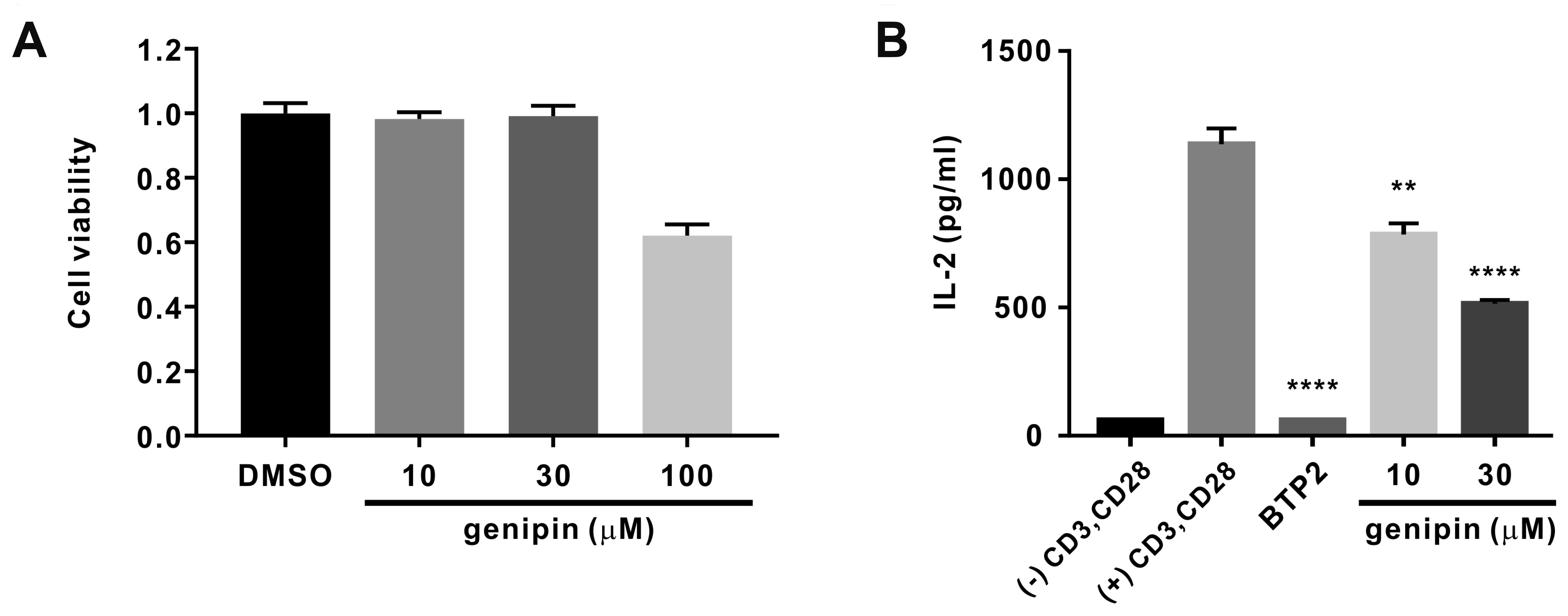1. Liu H, Chen YF, Li F, Zhang HY. 2013; Fructus Gardenia (
Gardenia jasminoides J. Ellis) phytochemistry, pharmacology of cardiovascular, and safety with the perspective of new drugs development. J Asian Nat Prod Res. 15:94–110. DOI:
10.1080/10286020.2012.723203. PMID:
23211013.
2. Deng Y, Guan M, Xie X, Yang X, Xiang H, Li H, Zou L, Wei J, Wang D, Deng X. 2013; Geniposide inhibits airway inflammation and hyperresponsiveness in a mouse model of asthma. Int Immunopharmacol. 17:561–567. DOI:
10.1016/j.intimp.2013.06.028. PMID:
23859870.

3. Sung YY, Lee AY, Kim HK. 2014; The
Gardenia jasminoides extract and its constituent, geniposide, elicit anti-allergic effects on atopic dermatitis by inhibiting histamine in vitro and in vivo. J Ethnopharmacol. 156:33–40. DOI:
10.1016/j.jep.2014.07.060. PMID:
25153023.
4. Koo HJ, Lim KH, Jung HJ, Park EH. 2006; Anti-inflammatory evaluation of gardenia extract, geniposide and genipin. J Ethnopharmacol. 103:496–500. DOI:
10.1016/j.jep.2005.08.011. PMID:
16169698.

6. Ko JW, Shin NR, Park SH, Cho YK, Kim JC, Seo CS, Shin IS. 2017; Genipin inhibits allergic responses in ovalbumin-induced asthmatic mice. Int Immunopharmacol. 53:49–55. DOI:
10.1016/j.intimp.2017.10.010. PMID:
29035815.

9. Woo JS, Srikanth S, Gwack Y. Kozak JA, Putney JW, editors. 2018. Modulation of Orai1 and STIM1 by cellular factors. Calcium entry channels in non-excitable cells. CRC Press;Boca Raton (FL): p. 73–92. DOI:
10.1201/9781315152592-4. PMCID:
PMC5369199.

11. Kim HJ, Nam YR, Kim EJ, Nam JH, Kim WK. 2018; Spirodela polyrhiza and its chemical constituent vitexin exert anti-allergic effect via ORAI1 channel inhibition. Am J Chin Med. 46:1243–1261. DOI:
10.1142/S0192415X18500659. PMID:
30149756.

12. Kim HJ, Woo J, Nam YR, Nam JH, Kim WK. 2019; Flos Magnoliae and its constituent linoleic acid suppress T lymphocyte activation via store-operated calcium entry. Am J Chin Med. 47:1627–1641. DOI:
10.1142/S0192415X19500836. PMID:
31659911.
13. Lee S, Youn K, Jun M. 2018; Major compounds of red ginseng oil attenuate Aβ25-35-induced neuronal apoptosis and inflammation by modulating MAPK/NF-κB pathway. Food Funct. 9:4122–4134. DOI:
10.1039/C8FO00795K. PMID:
30014084.

14. Gabay O, Sanchez C, Salvat C, Chevy F, Breton M, Nourissat G, Wolf C, Jacques C, Berenbaum F. 2010; Stigmasterol: a phytosterol with potential anti-osteoarthritic properties. Osteoarthritis Cartilage. 18:106–116. DOI:
10.1016/j.joca.2009.08.019. PMID:
19786147.

16. Park SH, An JE, Jang S, Kim JY, Lee JW, Kim HK. 2019;
Gardenia jasminoides extract without crocin improved atopic dermatitis-like skin lesions via suppression of Th2-related cytokines in Dfe-induced NC/Nga mice. J Ethnopharmacol. 241:112015. DOI:
10.1016/j.jep.2019.112015. PMID:
31173875.
17. Sung YY, Kim HK. 2018; Crocin ameliorates atopic dermatitis symptoms by down regulation of Th2 response via blocking of NF-κB/STAT6 signaling pathways in mice. Nutrients. 10:1625. DOI:
10.3390/nu10111625. PMID:
30400140. PMCID:
PMC6266819.

18. Srikanth S, Woo JS, Sun Z, Gwack Y. 2017; Immunological disorders: regulation of Ca
2+ signaling in T lymphocytes. Adv Exp Med Biol. 993:397–424. DOI:
10.1007/978-3-319-57732-6_21. PMID:
28900926.
19. Holowka D, Wilkes M, Stefan C, Baird B. 2016; Roles for Ca
2+ mobilization and its regulation in mast cell functions: recent progress. Biochem Soc Trans. 44:505–509. DOI:
10.1042/BST20150273. PMID:
27068962. PMCID:
PMC5293407.
20. Shanmugam MK, Shen H, Tang FR, Arfuso F, Rajesh M, Wang L, Kumar AP, Bian J, Goh BC, Bishayee A, Sethi G. 2018; Potential role of genipin in cancer therapy. Pharmacol Res. 133:195–200. DOI:
10.1016/j.phrs.2018.05.007. PMID:
29758279.

21. Habtemariam S, Lentini G. 2018; Plant-derived anticancer agents: lessons from the pharmacology of geniposide and its aglycone, genipin. Biomedicines. 6:39. DOI:
10.3390/biomedicines6020039. PMID:
29587429. PMCID:
PMC6027249.

22. Zhang Z, Wang X, Ma C, Li Z, Chen H, Zhang Z, Li T. 2019; Genipin protects rats against lipopolysaccharide-induced acute lung injury by reinforcing autophagy. Int Immunopharmacol. 72:21–30. DOI:
10.1016/j.intimp.2019.03.052. PMID:
30959368.

23. Yu SX, Du CT, Chen W, Lei QQ, Li N, Qi S, Zhang XJ, Hu GQ, Deng XM, Han WY, Yang YJ. 2015; Genipin inhibits NLRP3 and NLRC4 inflammasome activation via autophagy suppression. Sci Rep. 5:17935. DOI:
10.1038/srep17935. PMID:
26659006. PMCID:
PMC4675967.

24. Kim JS, Kim SJ, Lee SM. 2015; Genipin attenuates sepsis-induced immunosuppression through inhibition of T lymphocyte apoptosis. Int Immunopharmacol. 27:15–23. DOI:
10.1016/j.intimp.2015.04.034. PMID:
25921028.

25. Nam KN, Choi YS, Jung HJ, Park GH, Park JM, Moon SK, Cho KH, Kang C, Kang I, Oh MS, Lee EH. 2010; Genipin inhibits the inflammatory response of rat brain microglial cells. Int Immunopharmacol. 10:493–499. DOI:
10.1016/j.intimp.2010.01.011. PMID:
20123040.













 PDF
PDF Citation
Citation Print
Print


 XML Download
XML Download